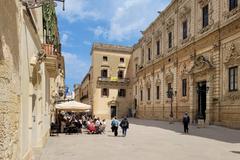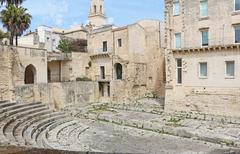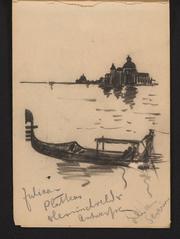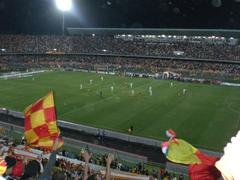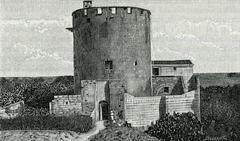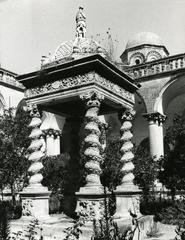Palazzo Turrisi Palumbo: Visiting Hours, Tickets, and History Guide – Lecce, Italy
Date: 14/06/2025
Introduction
Rising in the heart of Lecce’s historic center, Palazzo Turrisi Palumbo is a quintessential Baroque landmark that encapsulates the city’s aristocratic legacy and creative spirit. Built in the 17th century from the signature pietra leccese limestone, the palazzo is renowned for its elegant architecture, richly adorned courtyard, and continued role as a vibrant cultural venue. Over its long history, the building has transitioned from noble residence to ecclesiastical property, reflecting Lecce’s layered urban evolution.
This comprehensive guide provides essential details on Palazzo Turrisi Palumbo’s visiting hours, ticketing, accessibility, tours, highlights, and practical visitor insights. Whether you are a history enthusiast, architecture lover, or cultural explorer, this palazzo offers a unique window into Lecce’s past and present (Minube; InfoLecce; Hikersbay).
Table of Contents
- Overview and Significance
- Historical Background
- Architectural Features
- Cultural Role and Events
- Visitor Information: Hours, Tickets, Accessibility
- Nearby Attractions
- Visitor Tips and Experience
- Frequently Asked Questions (FAQ)
- Conclusion
- References and Further Reading
Overview and Significance
Situated among Lecce’s maze of Baroque palaces and churches, Palazzo Turrisi Palumbo stands as a symbol of the city’s noble past and ongoing cultural life. Its distinctive limestone facade, ornate balconies, and atmospheric courtyard exemplify the region’s architectural mastery. Today, the palazzo is not only an architectural gem but also a dynamic space for exhibitions, performances, workshops, and social integration projects (Minube; InfoLecce).
Historical Background
Built in the 17th century, the palazzo was originally the private residence of the influential Turrisi Palumbo family, whose status is reflected in the building’s size and ornamentation. Over time, the property passed to ecclesiastical ownership, serving as part of the local Curia Arcivescovile. This change is evident in subtle architectural shifts from secular grandeur to more austere, yet still elegant, religious features (Minube).
The palazzo’s history is emblematic of Lecce’s broader social and urban transformations, with noble residences often repurposed over centuries to serve new functions while preserving their historical essence.
Architectural Features
Facade and Structure
The palazzo’s facade is a harmonious blend of symmetry, decorative moldings, wrought-iron balconies, and subtle stone carvings—hallmarks of Lecce’s Baroque style. Pietra leccese, the golden limestone unique to the region, features prominently in both structural and decorative elements, allowing for intricate details and a distinctive warm hue (Minube).
The Courtyard
At the core of the palazzo is a stunning internal courtyard, a common feature in Mediterranean noble homes. This space is framed by colonnades with carved capitals, arches reflecting both Baroque and earlier influences, and stone floors that have borne witness to centuries of gatherings. The courtyard not only provided light and ventilation but also served as a focal point for social and ceremonial life.
Interior Highlights
While some areas are reserved for special events or guided tours, the interior layout typically includes a grand entrance hall with vaulted ceilings, reception rooms with possible frescoes or stuccoes, and a stately staircase. The upper floors, traditionally private apartments, may be less accessible due to historic staircases.
Cultural Role and Events
Palazzo Turrisi Palumbo has embraced a new role as a vibrant cultural and artistic venue:
- Exhibitions and Art Week: The palazzo regularly hosts exhibitions as part of events like Lecce Art Week, featuring contemporary Italian and international artists (InfoLecce).
- Theatrical and Multimedia Performances: Projects such as “Omaggio a Pier Paolo Pasolini” have brought immersive performances, photographic exhibitions, and debates to the palazzo’s historic spaces.
- Social Integration Initiatives: Programs like “Migrants du Monde” atelier foster cultural exchange and empowerment by uniting migrant women and locals in traditional embroidery and crafts.
- Educational Events: Lectures, workshops, and scholarly presentations contribute to the palazzo’s role as a center for learning and community engagement.
Visitor Information: Hours, Tickets, Accessibility
Visiting Hours
- Standard Hours: Tuesday–Sunday, 10:00 AM–6:00 PM
- Closed: Mondays and major public holidays
- Special Events: Extended hours or changes may occur; check the official website or local listings.
Tickets
- Adult Admission: €8 (average; may vary with special exhibitions)
- Discounts: Students, seniors, groups
- Children under 12: Free
- Special Events: Some exhibitions and events may offer free entry or require advance reservation
Tickets are available on-site and, for major events, via online booking (Hikersbay).
Accessibility
- Mobility: The courtyard and main floors have ramps for partial accessibility; however, historic upper floors are less accessible due to staircases.
- Facilities: Accessible restrooms and staff assistance are available. Contact the palazzo in advance for specific needs.
Tours
- Guided tours (in multiple languages) are available by advance reservation or during special events.
- Audio guides may be offered for select exhibitions (InfoLecce).
Nearby Attractions
Palazzo Turrisi Palumbo’s central location makes it a convenient starting point for exploring Lecce’s historic sites:
- Basilica di Santa Croce: Lecce’s most renowned Baroque church
- Piazza Sant’Oronzo: The city’s main square, ideal for dining and sightseeing
- Lecce Cathedral and Piazza del Duomo: Key religious and architectural landmarks
- Palazzo Bernardini: Another impressive noble residence nearby
Combine your visit to the palazzo with a stroll through Lecce’s enchanting streets, lined with artisan shops and traditional eateries (Hikersbay).
Visitor Tips and Experience
- Best Time to Visit: Early mornings or late afternoons for optimal lighting and fewer crowds
- Photography: Non-flash photography is generally permitted, especially in the courtyard and facade areas
- Attire: Wear comfortable footwear for walking on cobblestones
- Amenities: Restrooms, a gift shop, and a café (with courtyard views) enhance your visit
- Duration: Allocate 1.5–2 hours for the full experience, including exhibitions
For those unable to visit in person, the official website offers a virtual tour with high-quality images and interactive features.
Frequently Asked Questions (FAQ)
Q: What are the Palazzo Turrisi Palumbo visiting hours?
A: Typically 10:00 AM–6:00 PM, Tuesday to Sunday. Closed Mondays and public holidays.
Q: How much are tickets?
A: Around €8 for adults, with discounts for students and seniors. Children under 12 often enter free.
Q: Is the palazzo accessible for people with disabilities?
A: Partial accessibility—courtyard and main floors via ramps; upper floors may present challenges.
Q: Are guided tours available?
A: Yes, by advance reservation or during special events. Audio guides may also be available.
Q: What are nearby attractions?
A: Basilica di Santa Croce, Piazza Sant’Oronzo, Lecce Cathedral, and Palazzo Bernardini.
Conclusion
Palazzo Turrisi Palumbo bridges Lecce’s illustrious past with its vibrant present, offering visitors an immersive experience of Baroque architecture, cultural events, and community engagement. With its welcoming amenities, partial accessibility, and central position among Lecce’s historical gems, the palazzo is a cornerstone of the city’s artistic and social life.
For the most current information on visiting hours, tickets, and events, consult the official website and consider using digital resources like the Audiala app for exclusive guides and updates.
References and Further Reading
- Palazzo Turrisi – Palumbo in Lecce: History, Architecture, Visiting Hours, Tickets & Visitor Guide, 2024, Minube
- Palazzo Turrisi Palumbo: Visiting Hours, Tickets, and Architectural Highlights in Lecce, 2024, Minube
- Palazzo Turrisi-Palumbo Visiting Hours, Tickets & Cultural Significance in Lecce, 2024, InfoLecce
- Palazzo Turrisi-Palumbo Museum in Lecce: Visiting Hours, Tickets & Visitor Guide, 2024, Official Museum Website
- Palazzo Turrisi Palumbo, Hikersbay, 2024
